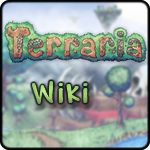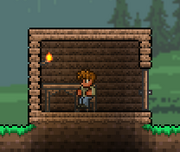
A basic House.
9 (exterior width) x 7 (exterior height)
A House (or Home) is a structure built by the player that Town NPCs require in order to spawn, with one House required per NPC. A structure must meet several requirements in order to function as a House (see details below). You can check if a structure meets the requirements by using the Housing Menu's top button, labeled with a question mark ("?"). NPCs generally retreat to their Houses at night and remain in them until dawn. They will also retreat to their houses during a Solar Eclipse or Rain.
The Guide will appear upon starting a new world, and if killed, he will require a House in order to respawn. The Old Man, the Traveling Merchant, and the Skeleton Merchant do not require Houses.
Similarly, the Guide, Angler, Goblin Tinkerer, Mechanic, Stylist, Wizard, and Tavernkeep will each make their initial appearances regardless of available housing. Once initially found, each will require a suitable House before respawning.
Certain naturally-generated structures can serve as Houses and may inadvertently attract NPCs if players have placed light sources within them. These can include Living Tree treasure rooms and Floating Island structures. NPCs can be moved from these to the player's structures using the Housing Menu.
The requirements for a player-selected Bed to work as a spawn point are similar to those for NPC housing, but weaker. Players do not need furniture beyond the bed. See the Beds page for full details.
Housing Menu

 PC,
PC,  Console,
Console,  Mobile,
Mobile,  Old Chinese,
Old Chinese,  tModLoader, and
tModLoader, and  tModLoader Legacy Housing Menu
tModLoader Legacy Housing Menu
The menu for managing the placement of NPCs, accessed through clicking the small house icon above the armor slots.
The Housing menu allows you to check whether the houses you have built are suitable for use or not, as well as to manually appoint a house for a specific NPC. To access this menu, click on the house icon in your inventory.
To check whether a house is suitable for use, click on the "?" housing query mark and then click anywhere inside the house; you will receive a message indicating whether the house is suitable or not. If it is not suitable, you can check the house requirements further down this page to see what the house may be lacking.
Once a house is determined to be suitable, you may assign an NPC to it by placing the corresponding NPC Flag in it. Note that only the flags of NPCs whose spawn conditions you have already met will appear. For example, when you first enter a new world, only the Guide's NPC Flag is shown. NPC Flags for other NPCs will only be shown when you meet each of their spawn conditions. On the ![]() PC version,
PC version, ![]() Console version,
Console version, ![]() Mobile version,
Mobile version, ![]() Old Chinese version,
Old Chinese version, ![]() tModLoader version, and
tModLoader version, and ![]() tModLoader 1.3-Legacy version, NPC Flags have two different appearances: solid red and red with a golden frame. NPCs that move in by their own will have a regular red flag. If they are assigned to a house, the banner will have a golden frame. This indicates that if the NPC currently inhabiting the home were to die, the replacement for that NPC would move into that specified home. Due to this, a golden NPC flag will not disappear unless the home it is in is destroyed or the NPC is reassigned.
tModLoader 1.3-Legacy version, NPC Flags have two different appearances: solid red and red with a golden frame. NPCs that move in by their own will have a regular red flag. If they are assigned to a house, the banner will have a golden frame. This indicates that if the NPC currently inhabiting the home were to die, the replacement for that NPC would move into that specified home. Due to this, a golden NPC flag will not disappear unless the home it is in is destroyed or the NPC is reassigned.
In the ![]() Old-gen console version, the housing menu can be opened by pressing Inventory and navigating to the housing menu. To check whether a house is valid, press Quick Buff and the housing status of the house you are standing in will be printed in chat.
Press Inventory to show/hide room flags.
Old-gen console version, the housing menu can be opened by pressing Inventory and navigating to the housing menu. To check whether a house is valid, press Quick Buff and the housing status of the house you are standing in will be printed in chat.
Press Inventory to show/hide room flags.
When you first meet the spawn conditions for an NPC, a random house will be assigned to them from your available empty suitable houses.
Framework
A house must be fully enclosed with the following features:
- The side walls (vertical blocks) can be made of blocks, Doors, Platforms or Tall Gates.
- The floor and ceiling (horizontal blocks) can be made of blocks, Trap Doors or Platforms. The whole floor cannot be made of platforms.
- Including the above frame (floor, side walls, and ceiling), a house must have at least 60 total tiles, but less than 750.
- The house must include a light source, a "flat surface" item, and a "comfort item". The smallest and simplest items which qualify are respectively a torch, a workbench, and a chair.
- The NPC needs at least one solid (non-platform) block to stand on at night, and (except
) a 2x3 area unobstructed by foreground blocks. These blocks may not be directly adjacent to either of the 2 side walls of the house. The NPC standing area may overlap with the flat or comfort items, but not with the light source. - A house must have at least one "entrance", which can be a Door or Tall Gate in a side wall, a Trap Door in the ceiling or floor, or a Platform in the ceiling, floor, or side walls. This entrance does not need to be usable by the NPC (for example, NPCs can't use trap doors) nor does it have to lead "outdoors".
Note: The parts of the frame need to be adjacent horizontally or vertically; a single diagonal row of blocks does not count. A zigzag stair of blocks does, even if it's hammered to look like a smooth diagonal wall. A wall can include a column of platforms, but staircases are not acceptable (even if doubled).
Size
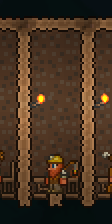
A miniature 3×10 house.
Again, a house must have at least 60 but fewer than 750 total tiles including the frame around it. Therefore, the dimensions of a House's outer frame must meet one of the following minimum requirements:
| Excluding ceiling, floor and walls | Including ceiling, floor and walls |
|---|---|
| 3 tiles wide × 10 tiles high [1] | 5 tiles wide × 12 tiles high |
| 4 tiles wide × 8 tiles high | 6 tiles wide × 10 tiles high |
| 5 tiles wide × 7 tiles high | 7 tiles wide × 9 tiles high |
| 6 tiles wide × 6 tiles high | 8 tiles wide × 8 tiles high |
| 7 tiles wide × 5 tiles high | 9 tiles wide × 7 tiles high |
| 8 tiles wide × 4 tiles high | 10 tiles wide × 6 tiles high |
| 10 tiles wide × 3 tiles high | 12 tiles wide × 5 tiles high |
| 13 tiles wide × 2 tiles high |
15 tiles wide × 4 tiles high |
- ↑ Only possible when using a Work Bench instead of a table.
- ↑ Only possible when using platforms as a ceiling. No longer possible on PC, Console, Mobile, Old Chinese, tModLoader, and tModLoader Legacy.
Background Walls
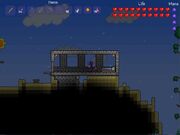
A House with "windows" before the 1.1 Update, which added Glass Walls.
A house must have a background wall in order to be suitable.
- Walls not placed by a player (such as naturally-occurring dirt walls) do not count, with the exception of Disc Walls in Floating Islands, the Planked Walls found in Underground Cabins, the Living Wood Walls in Living Tree rooms, or the Sandstone Brick Walls found in Pyramid structures. Dirt walls placed by the player do work.
- Background walls may contain holes if the holes are no taller or wider than four tiles. (e.g. 4 background tiles across or tall, so the maximum size allowed is 4x4, 16 tiles in total.). Walls may have multiple holes as long as they are separated by at least a single tile of background walls.
- Having background holes may sometimes allow enemies to spawn within the House. To create windows more safely, place sections of Glass Wall instead.
Furniture requirements
A House must have at least one valid Light source, Flat Surface item, and Comfort item placed within it. The items listed below will fulfill these requirements.
- Not every item that provides light will fulfill a House's light source requirement; in particular, no "foreground blocks", platforms, or walls qualify. You must use one of the furniture items listed below.
- Any type of each item listed below will fulfill the requirement. For example, any color Torch will work, as will any theme of Chairs.
Light sources
Template:Item/options
Flat surface items
Comfort items
Template:Item/options
Location
If a House is located near Corruption or Crimson blocks it may become uninhabitable. If these biomes spread near an occupied House the NPC living there may move out and wander the area until a new House becomes available.
A House is considered Corrupted based on its "Corruption rating," which is calculated using all tiles in a 45-block "radius" around the house. In order to be valid a House's Corruption rating must be less than 65.
- Each tile of Corrupt/Crimson grass, Ebonstone/Crimstone, Ebonsand/Crimsand, Corruption/Crimson Thorny Bushes and Corruption (but not Crimson) tall grass/Vile Mushrooms increases a House's Corruption rating by 1.
- Each tile of Hallowed grass, Hallowed tall grass/flowers/vines, Pearlstone or Pearlsand reduces the Corruption rating by 1.
- Each Sunflower reduces a House's corruption rating by 40.
If the rating is equal to or greater than 300 the message "This housing is corrupted." is displayed; if 65 or greater, but lower than 300, the less specific message "This is not valid housing." is displayed instead.
Factors which lower the Corruption rating also seem to count against the number of blocks needed for either Evil Biome. The Corruption and Crimson each require a minimum of 200 relevant blocks, or a Corruption rating of 200 or more, to exist. Because of this system a House can never be valid if inside an active Corruption or Crimson biome. This can make biome requirements, most notably for the Painter, a bit of work to fulfill.
One NPC, Truffle, also has the special condition that his home must be in a Glowing Mushroom biome.
A Simple, Valid house
A simple valid house.
Materials required:
- 25 Dirt Blocks for floor, wall and ceiling.
- 32 crafted Dirt Walls (8 Dirt Blocks) for background wall.
- Wooden Door (6 Wood). Can be replaced with one Wood Platform.
- Wooden Chair (4 Wood).
- Wooden Table (8 Wood) or Work Bench (10 Wood).
- Torch (1 Wood, 1 Gel, results 3 torches).
Summary raw materials:
- 33 Dirt Blocks
- 19 Wood if using a door, 14 Wood if using a single wood platform.
- 1 Gel
This works, but if you don't want your house to be occupied by vines, replace dirt with wood, stone, or mud. While this is a simple option, it's susceptible to Corruption, Crimson or Hallow in Hardmode.
Achievements



Notes
- Houses may be attached together and share common walls, floors, ceilings, and doors. What looks to the player like a multi-room house or apartment complex looks to the NPCs like a collection of independent houses.
- Nearly any NPC house will qualify for a player to place and use a bed as their spawn point, so long as the tiles immediately above the bed are clear (see the Beds page for full details). The bed also counts as a comfort item.
- If a House with an assigned NPC is destroyed or any of its requirements are invalidated, the NPC will wander the area until a valid House becomes available again. If killed, the NPC will respawn once a valid house is restored.
- An NPC will not spawn within its House if that House is on the visible screen at the time, and may walk around the area outside instead. Quitting and restarting in single-player mode will place the NPC in its house. At night, NPCs will be automatically placed inside their Houses if the player travels several screens away, or if the player uses a Magic Mirror, Teleporter, or Ice Mirror.
- The side, top, and bottom of the world will not count as walls.
- If a stone wall has been converted into Pearlstone Wall, the House will become invalid.
- If building a house at a world's original spawn point, it is best to not place any foreground objects or blocks where characters appear. This will remove the object(s) and place them in the player's inventory.
- If the house is placed in the original spawn point, if the player teleports back or respawns a portion of the house can be destroyed.
Tips
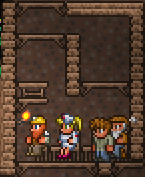
An infinite house. It no longer works as of version 1.3.1, but it should still work for the  Mobile.
Mobile.
- Actuators can be used with Brown, Gray, and Lihzahrd Pressure Plates to allow players entry but prevent enemies from entering or NPCs from leaving. Trap Doors can also be used, as neither enemies nor NPCs can open them.
 PC version After the 1.3.1 update, it is very useful and convenient to use a Player Sensor instead of pressure plates, as you will not only have much more ground space to use but you can also activate the Actuators or Trap Door from simply being in the proximity of them. Note that the Player Sensor itself is not a valid block for the house frame; if it is used as part of the floor, ceiling, or side walls (including corners), the house will not be valid.
PC version After the 1.3.1 update, it is very useful and convenient to use a Player Sensor instead of pressure plates, as you will not only have much more ground space to use but you can also activate the Actuators or Trap Door from simply being in the proximity of them. Note that the Player Sensor itself is not a valid block for the house frame; if it is used as part of the floor, ceiling, or side walls (including corners), the house will not be valid.
- If absolutely necessary (e.g. on
, where there's no housing menu), players can force an NPC into a particular house by destroying all the others.
- Hardmode natural walls, such as Pearlstone and Ebonstone walls, do not count as valid walls.
- The "Infinite House" exploit will always work on old-gen consoles (Xbox 360, Wii U & PS3), due to the fact that these consoles will not receive further updates to Terraria.[1]
- As long as the house meets the size criteria, it can be any shape, not just rectangles and squares. (e.g. You can have a dome shaped house and it would still be viable.)
- Houses are good places for players to indulge their creativity -- while the NPCs themselves will be happy with bare cells, it is entertaining to provide them with decorated and themed homes.
References
History
- Desktop 1.3.5.3: Fixed an error when trying to use the room query on an unfit room in certain languages.
- Desktop 1.3.5: NPCs who are manually assigned to a room will have their successor attempt to move in when the original is killed.
- Desktop 1.3.1: Removed the "Infinite House" glitch.
- Desktop 1.3.0.5: Living Leaf Walls can now be used as a background for houses.
- Desktop 1.3.0.1: Blue Slab Walls from the Dungeon are now detected as valid for Houses.
- Desktop 1.2.4.1: Opening doors will once again cause a room to be unsuitable, but only if two doors are opened into the same room. (Depends on size of room)
- Desktop 1.2: Fixed a bug that would cause a suitable house to be unsuitable.
- Desktop 1.1: There is now a Housing Menu (a built-in interface) for checking if a house is valid for being moved into, and for assigning NPCs to specific houses.
